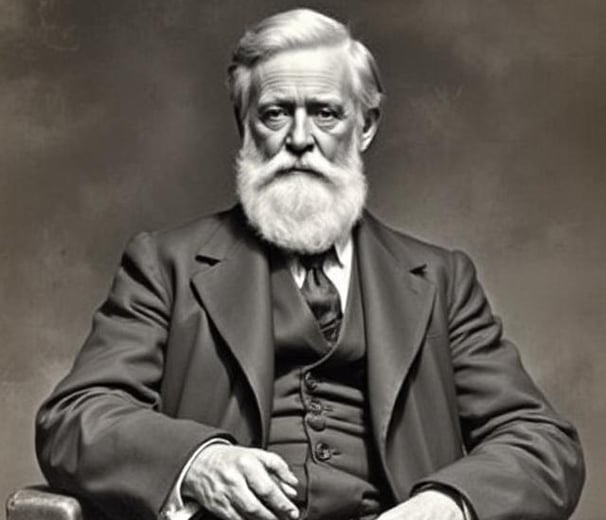The Future of Knowledge is up for Grabs: The Next Big Billionaire Move Should be Libraries
Who will be the Next Andrew Carnegie?


Andrew Carnegie’s legacy looms large among libraries. Carnegie was a steel magnate turned visionary philanthropist who reshaped public access to knowledge by funding the construction of libraries worldwide, opening doors for millions to learn, dream, and create better futures. Would it be possible to do something like that today? I’m not just talking about building libraries. I’m talking about rethinking what a modern library could be. Could a billionaire today reimagine Carnegie’s vision and ignite a bold new future for libraries?
The Power of a Billionaire’s Vision
In 1901, Carnegie sold his steel manufacturing company to industrialist J.P. Morgan for $480 million—worth about $14 billion today! To put things in perspective for 2025, the top nine richest people on the planet all have a net worth over $100 billion.
Carnegie spent approximately $1.8 billion in today’s dollars to construct 1,600 libraries in the U.S. He believed rich people should use their money to help others. If a modern-day philanthropist had Carnegie’s same ambition, the possibilities are staggering. But instead of just brick-and-mortar buildings, a bold new vision for libraries could take many forms:
• A Nationwide Digital Library Network: Imagine a billion-dollar investment creating a seamless, unified e-library system accessible to every American. No paywalls, no regional restrictions—just knowledge at everyone’s fingertips. This idea relieves local libraries of the burden of acquiring, funding, and managing the rapidly increasing demand for e-resources so librarians can do the work that really matters – helping the people in their communities with literacy, learning, civic engagement, and social innovation!
• Makerspaces & Innovation Labs: Libraries could amp up their makerspaces and innovation labs to house community robotics labs, VR creation stations, and collaborative tech spaces, giving everyone the tools to build and invent. If we are going to thrive in the future, libraries have to be leaders when it comes to democratizing access to technology and helping people understand its awesome power.
• AI-Powered Personalized Learning Spaces: Interactive AI tutors and adaptive learning stations could transform how people access and process information. As education and learning becomes more diffused, libraries could be leaders in tailored learning experiences that cater to different learning styles by providing customized lessons and instruction, 24/7 access that eliminates barriers and allows individuals to learn at their own pace, and language translation accessibility features. This could be a game-changer for communities, especially those with limited access to traditional educational institutions.
What Could a Billion-Dollar Library Investment Do Today?
Let’s break down the numbers:
• A today’s market prices, a $1 billion investment could fund 100 next-generation libraries, two per state, equipped with cutting-edge technology and community services. This is nice, but it’s not world changing.
• A $10 billion investment builds 500 libraries or creates a nationwide, free digital learning platform available to every citizen. This takes learning management systems like Blackboard and Canvas to a whole new level and enables every individual of any age to have access to free training modules with a built-in certified and authenticated “digital transcript” that acts like a repository for your skills, badges, degrees, company training, awards, etc. all in one place – and it follows you wherever you go.
• A $100 billion investment is for world bangers who want to truly make a difference in the lives of millions of people for generations just like Carnegie. $100 billion transforms libraries like we’ve never seen before, turning them into the knowledge hubs of the future—integrating technology, education, and sustainability to serve as 21st-century learning epicenters. With $100 billion, libraries wouldn’t just be places to check out books or access the internet—they’d become innovation ecosystems, offering AI-driven learning, sustainable infrastructure, high-speed connectivity and computing power, and equitable access to knowledge and tools of the future ensuring that every person, regardless of background, has the tools to learn, grow, and succeed.
Do We Need More Buildings or a New Model?
The 20th-century library was a place of books. The 21st-century library must be a place of ideas, access, and innovation. Physical spaces still matter, especially in underserved areas, but the future of libraries isn’t just about physical locations—it’s about connection. A bold philanthropist today could take Carnegie’s dream even further, creating an ecosystem of knowledge that reaches beyond walls and into every home, every device, and every mind hungry to learn.
Who Will Step Up?
We live in an era where billionaires launch rockets, create virtual realities, and harness AI. But what if one of them set their sights on a new frontier—one that curates humanity over machines? It is exactly what we’re trying to do at Believe Harder.
Libraries remain one of the greatest public investments. They provide access to information, encourage lifelong learning, and help people improve their live, which is why Carnegie’s gift was so critical. Libraries are more than buildings; they are about access, empowerment, and opportunity. Carnegie’s idea was a moonshot and it has paid off a hundred-fold. Who will be the next Carnegie? Who will redefine the future of libraries for generations to come? Perhaps the real question is: Will a billionaire today dare to dream this big? The future of knowledge depends on it.
We can do it together if we Believe Harder.
